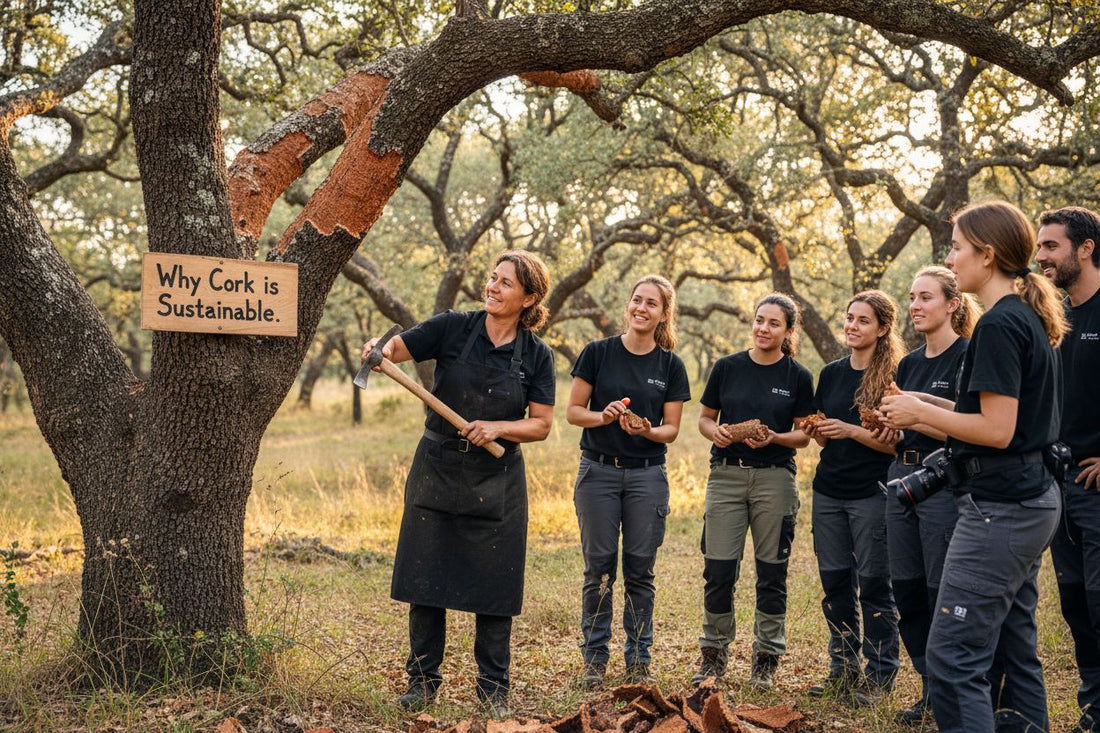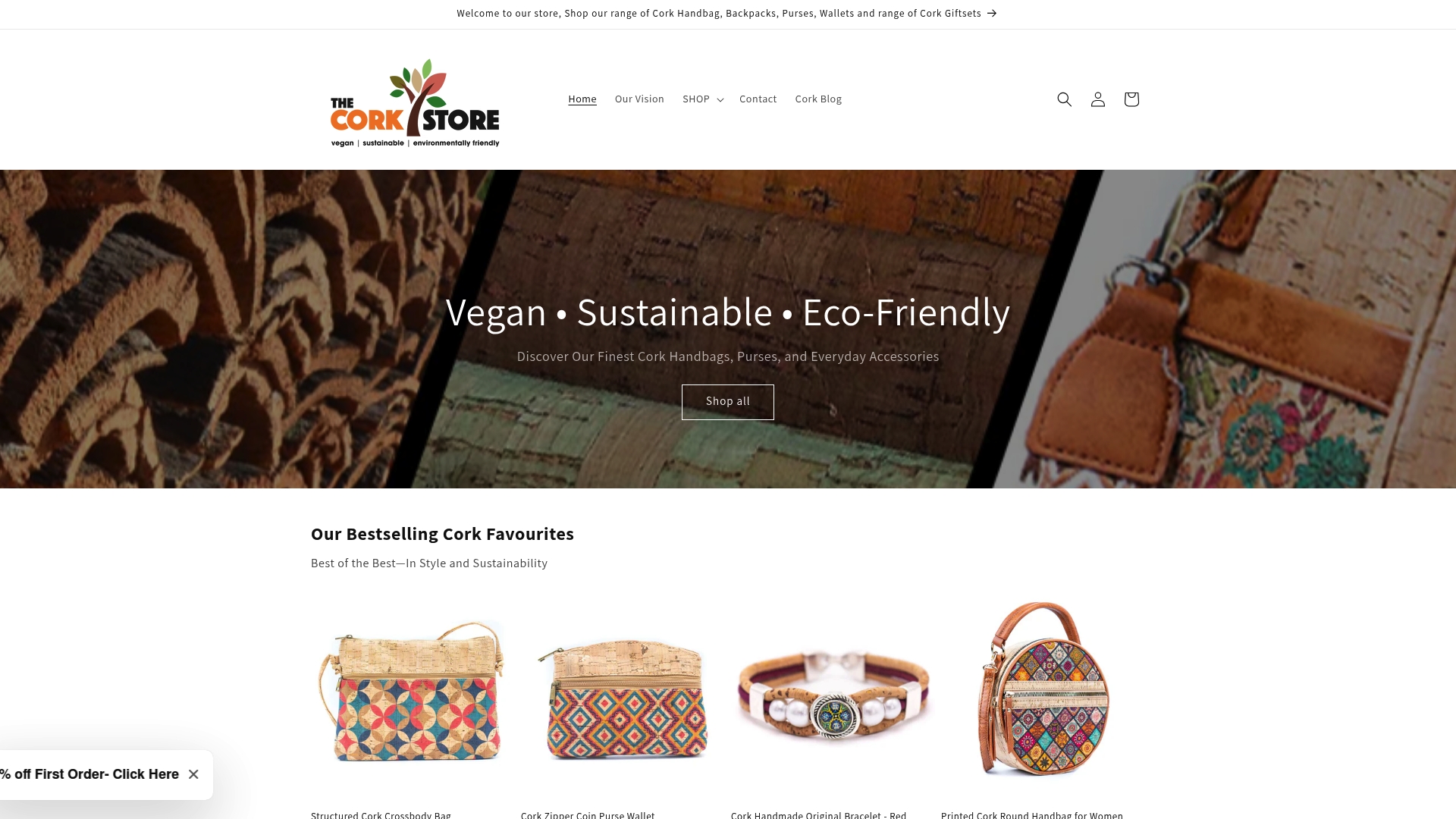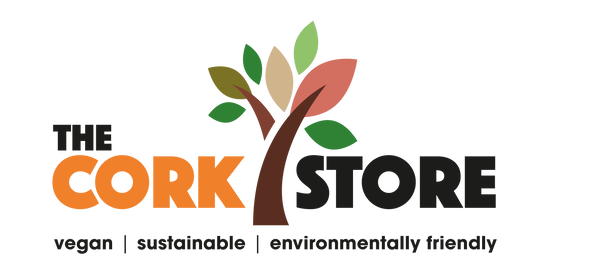
Understanding Why is Cork Sustainable for Our Planet
Share
Cork might sound like just the stuff sealing your favourite wine bottle, yet it holds a claim to sustainability few materials can touch. Imagine a single cork oak tree being harvested for its bark every 9 to 12 years without any lasting harm to the tree itself. That alone would be impressive, but cork goes even further. Each hectare of cork forest can absorb around 4.8 tonnes of carbon dioxide annually, making it not just a renewable resource but a real force for fighting climate change.
Table of Contents
- What Is Cork And How Is It Harvested?
- Why Cork Is An Eco-Friendly Material?
- The Role Of Cork In Biodiversity And Ecosystems
- How Cork Production Supports Local Communities
- What Makes Cork A Versatile And Sustainable Choice?
Quick Summary
| Takeaway | Explanation |
|---|---|
| Cork is harvested sustainably | Cork oak trees are stripped without harming them, allowing multiple harvests throughout their lives. |
| Cork forests support biodiversity | These ecosystems are habitats for endangered species and contribute to environmental stability. |
| Cork absorbs significant carbon dioxide | Each hectare of cork forest captures about 4.8 tonnes of CO2 annually, aiding climate change efforts. |
| Cork production supports local economies | The industry provides stable employment and economic resilience in rural Mediterranean communities. |
| Cork offers unique physical properties | Lightweight, durable, and resistant, cork adapts well across various industries, from fashion to construction. |
What is Cork and How is it Harvested?
Cork represents a remarkable natural material derived from the bark of cork oak trees (Quercus suber), primarily found in Mediterranean regions like Portugal, Spain, and parts of North Africa. This extraordinary resource embodies sustainable harvesting practices that make it a standout material in ecological conservation.
The Unique Biology of Cork Oak Trees
Unlike most tree harvesting methods that require cutting down entire trees, cork extraction is an exceptionally gentle process that allows the tree to continue living and regenerating. Our guide on sustainable cork production provides deeper insights into this remarkable process.
The cork oak tree possesses a thick, spongy bark layer that can be carefully stripped without causing permanent damage. Professional cork harvesters use specialised axes to remove bark sections, ensuring they do not penetrate the tree’s inner living layers. This meticulous technique means a single cork oak tree can be harvested multiple times throughout its lifetime, typically every 9 to 12 years.
Sustainable Harvesting Techniques
According to research from the Cork Oak Forest Observatory, cork harvesting is a highly regulated and environmentally conscious process. The extraction follows strict guidelines to protect tree health:
- Harvesting begins when the tree reaches approximately 25 years old
- Only skilled workers with specialized tools perform the extraction
- Bark is carefully removed during the tree’s most active growth period (typically summer months)
- Each extraction leaves the tree intact and capable of continued bark regeneration
Interestingly, cork harvesting contributes positively to forest ecosystems. By maintaining live, healthy cork oak forests, we support biodiversity, prevent soil erosion, and create natural carbon sinks that help mitigate climate change. These forests serve as critical habitats for numerous plant and animal species, making cork not just a sustainable material, but an ecological asset.
The table below summarises the key environmental and socioeconomic benefits of cork production, providing a clear comparison of the ways cork supports both ecosystems and local communities.
| Benefit Area | How Cork Supports Sustainability |
|---|---|
| Ecosystem Health | Maintains live forests, prevents soil erosion, and creates natural carbon sinks |
| Biodiversity | Provides habitats for endangered species and supports diverse flora and fauna |
| Carbon Sequestration | Each hectare absorbs about 4.8 tonnes of CO2 annually |
| Community Economic Resilience | Offers stable employment and preserves traditional skills in rural areas |
| Sustainable Livelihood | Supports long-term economic stability for Mediterranean communities |
| Resource Efficiency | Harvesting does not harm trees, allows multiple harvests, and minimises waste |
The entire process demonstrates how human intervention can work harmoniously with natural systems, producing a versatile material without causing environmental harm.
Why Cork is an Eco-Friendly Material?
Cork stands out as an exceptional eco-friendly material, embodying sustainable principles from its core biological characteristics to its environmental impact. Unlike synthetic or heavily processed materials, cork represents a naturally renewable resource that supports ecological balance while delivering remarkable performance.
Carbon Sequestration and Climate Benefits
One of the most compelling arguments for cork’s environmental credentials is its extraordinary ability to absorb carbon dioxide. Our comprehensive guide on eco-friendly materials in fashion explores this fascinating aspect in greater depth.
According to research from the World Wildlife Fund, cork oak forests are powerful carbon sinks. During bark regeneration, these trees continue capturing atmospheric carbon, with each hectare of cork forest absorbing approximately 4.8 tonnes of carbon dioxide annually. This remarkable capacity makes cork forests critical contributors to global climate change mitigation strategies.
Minimal Environmental Processing
Cork’s sustainability extends beyond carbon sequestration into its production and processing. The material requires minimal industrial intervention, preserving its natural ecological footprint:
- No chemical treatments are necessary during initial harvesting
- Energy consumption during cork processing remains significantly lower compared to synthetic materials
- Production generates minimal waste, with almost every part of harvested bark being utilisable
- Manufacturing processes do not require water-intensive procedures
Moreover, cork products demonstrate exceptional durability and biodegradability. When a cork product reaches the end of its lifecycle, it can decompose naturally without releasing harmful toxins into the environment.
![]() This characteristic stands in stark contrast to petroleum-based synthetic materials that persist in ecosystems for hundreds of years.
This characteristic stands in stark contrast to petroleum-based synthetic materials that persist in ecosystems for hundreds of years.
The intrinsic properties of cork highlight how natural materials can provide sustainable alternatives to resource-intensive manufacturing processes. By choosing cork, consumers actively participate in supporting ecological preservation and responsible resource management.
The Role of Cork in Biodiversity and Ecosystems
Cork oak forests represent extraordinary ecological landscapes that extend far beyond simple timber production, serving as complex, interconnected ecosystems that support remarkable biodiversity and environmental stability. These unique forest systems play a critical role in maintaining ecological balance and preserving wildlife habitats.
A Haven for Endangered Species
Our guide on sustainable cork production illuminates the incredible environmental significance of these landscapes. According to research from the International Union for Conservation of Nature, cork oak forests are biodiversity hotspots that provide sanctuary to numerous endangered and rare species.
These forests support an intricate web of life, offering critical habitats for animals that cannot survive in other environments. Rare species like the Iberian lynx, Spanish imperial eagle, and multiple endemic plant varieties depend on the unique microclimate and ecological conditions created by cork oak woodlands.
Ecosystem Services and Environmental Protection
Beyond supporting wildlife, cork oak forests deliver essential ecosystem services that contribute to environmental sustainability:
- Preventing soil erosion through extensive root systems
- Maintaining groundwater reserves and regulating local hydrological cycles
- Creating natural firebreaks that reduce wildfire propagation
- Supporting agricultural diversity through symbiotic relationships with surrounding landscapes
The complex root networks of cork oak trees stabilise soil structures, preventing landslides and protecting against desertification. This makes these forests critical guardians of landscape integrity, especially in regions prone to environmental degradation.
Moreover, cork oak ecosystems represent living examples of sustainable land management. By maintaining these forests, human communities simultaneously preserve biodiversity, support local economies, and contribute to global environmental conservation efforts. The delicate balance between human interaction and natural ecosystem maintenance demonstrates how thoughtful resource management can create mutually beneficial relationships between human societies and natural environments.
How Cork Production Supports Local Communities
Cork production represents more than an environmental solution; it is a vital economic lifeline for numerous rural communities across Mediterranean regions, particularly in Portugal, Spain, and parts of North Africa. This intricate industry provides sustainable livelihoods while preserving traditional ecological knowledge and supporting intergenerational economic stability.
Economic Resilience and Traditional Skills
Our collection of unique cork gifts highlights the cultural significance of this remarkable material. According to research from the Cork Observatory, the cork industry directly employs approximately 60,000 people across rural communities, with many families having practiced cork harvesting for multiple generations.
These skilled workers possess specialized knowledge passed down through centuries, understanding the delicate techniques required for responsible bark extraction. The expertise involves precise cutting methods that ensure tree health and maximize sustainable bark production, representing a profound connection between human skill and natural resource management.
Socioeconomic Impact and Community Development
The cork industry generates significant economic opportunities in regions often challenged by limited agricultural alternatives:
- Provides stable, year-round employment in rural areas
- Supports local agricultural economies beyond traditional farming
- Creates downstream economic opportunities in processing and manufacturing
- Helps prevent rural depopulation by offering meaningful work
Moreover, cork production supports broader community development initiatives. Many cork-producing regions reinvest industry revenues into local infrastructure, education, and healthcare systems. This economic model demonstrates how sustainable resource management can create holistic community benefits, transforming environmental stewardship into tangible social progress.
By choosing cork products, consumers directly contribute to maintaining these delicate ecological and social ecosystems, supporting communities that have developed sophisticated, sustainable relationships with their natural environments.
What Makes Cork a Versatile and Sustainable Choice?
Cork emerges as an extraordinary material that transcends traditional sustainability concepts, offering unparalleled versatility across multiple industries and applications. Its unique physical properties and ecological credentials position it as a revolutionary alternative to conventional materials, addressing contemporary environmental and design challenges.

Remarkable Physical Properties
Our comprehensive guide on cork leather explores the material’s exceptional characteristics. According to research from Materials Science journals, cork possesses extraordinary attributes that make it suitable for diverse applications:
- Extremely lightweight yet remarkably durable
- Natural water and fire resistance
- Excellent thermal and acoustic insulation properties
- Hypoallergenic and antimicrobial surface
These properties enable cork to perform exceptionally in contexts ranging from fashion accessories to architectural design, construction materials, and even aerospace engineering. Its cellular structure provides natural cushioning and resilience, making it an ideal material for products requiring both functionality and environmental responsibility.
This table outlines the physical properties of cork and their practical benefits, illustrating why cork is regarded as a highly versatile and sustainable material across different industries.
| Physical Property | Explanation / Practical Benefit |
|---|---|
| Lightweight | Easy to handle and transport |
| Durability | Long-lasting and able to withstand wear |
| Water Resistance | Does not absorb water easily, prevents rotting |
| Fire Resistance | Naturally resistant to combustion |
| Thermal & Acoustic Insulation | Retains heat and dampens sound |
| Hypoallergenic & Antimicrobial | Resists mould, dust, and is suitable for allergies |
| Cushioning & Resilience | Provides shock absorption and flexibility |
Adaptability Across Industries
Unlike many materials limited to specific applications, cork demonstrates remarkable adaptability. Manufacturers have successfully transformed cork into innovative products including:
-
Sophisticated fashion accessories
-
High performance sports equipment
-
Architectural building materials
-
Medical and scientific instrumentation
-
Sustainable packaging solutions
This versatility stems from cork’s inherent molecular structure, which allows for complex processing techniques that maintain its core ecological advantages. By reimagining traditional material constraints, designers and engineers continue discovering revolutionary applications that showcase cork’s potential as a sustainable, high-performance material.
Ultimately, cork represents more than just an alternative material. It embodies a holistic approach to design that harmonises environmental stewardship with cutting-edge technological innovation, offering solutions that are both ecologically responsible and functionally superior.
Ready to Choose True Sustainability?
You have just explored how cork delivers real environmental benefits, from supporting biodiversity to driving responsible economic growth. If you are passionate about reducing your impact and embracing eco-friendly choices, the pain point is clear: traditional materials often harm the planet and limit our options. Cork’s unique renewal cycle, gentle harvesting, and carbon-capturing power shine as a solution for anyone seeking kinder alternatives. Why settle for accessories that compromise the earth, when you can make a positive difference?

Transform your values into daily action today. Discover our curated range of sustainable, animal-friendly cork accessories right now on The Cork Store. Every product embodies everything you have learnt about cork’s remarkable benefits. Ready to upgrade your wardrobe or gifts? Start browsing our latest unique cork gift ideas and explore our cork leather collection for style that does not cost the planet. Act now to enjoy ethical elegance and sustainable confidence with your next purchase.
Frequently Asked Questions
What is cork and how is it harvested?
Cork is a natural material obtained from the bark of cork oak trees. Its harvesting is done gently to allow the tree to continue living, typically every 9 to 12 years, using specialised techniques that do not damage the tree.
Why is cork considered an eco-friendly material?
Cork is eco-friendly due to its ability to absorb carbon dioxide, minimal environmental processing requirements, and natural durability. It decomposes without releasing harmful toxins, unlike synthetic materials.
How does cork production support local communities?
Cork production provides stable employment, supports local economies, and preserves traditional ecological knowledge. It helps develop community infrastructures and services, enhancing the lives of those involved in the industry.
What are the unique physical properties of cork?
Cork is lightweight, durable, water and fire-resistant, and has excellent insulation properties. It is also hypoallergenic and antimicrobial, making it suitable for a variety of applications across different industries.
